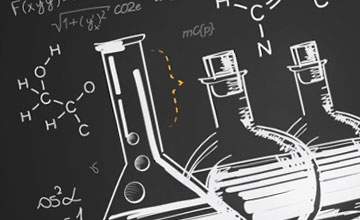Robert K. Thomson
- Courses4
- Reviews7
- School: University of Oklahoma
- Campus:
- Department: Chemistry
- Email address: Join to see
- Phone: Join to see
-
Location:
660 Parrington Oval
Norman, OK - 73019 - Dates at University of Oklahoma: February 2013 - May 2015
- Office Hours: Join to see
Biography
University of Oklahoma - Chemistry
Experience
The University of British Columbia
Graduate Research Assistant
Developed neutral and cationic group 4 catalysts for the cyclohydroamination reaction. Studied the mechanism of action through kinetics analysis and intermediate isolation.
The University of British Columbia
Lecturer
Taught introductory chemistry courses to 800+ students. Taught chemistry and science communication courses incorporating scientific outreach and presentation of data and concepts through various modes of media, including oral presentations, blogging, podcasts, and video productions.
University of Oklahoma
Assistant Professor
Research into new types of thorium-based nuclear fuel sources, generation of new P-containing polymers through novel routes, and study of high-oxidation state Fe complexes for C-H bond activation. Teaching synthesis and spectroscopy.
Los Alamos National Laboratory
Postdoctoral Research Associate
Discovered new methods and approaches to generating uranium nitrides.
Education
The University of British Columbia
Ph.D.
Inorganic Chemistry
The University of British Columbia
B.Sc.
Chemistry
The University of British Columbia
Graduate Research Assistant
Developed neutral and cationic group 4 catalysts for the cyclohydroamination reaction. Studied the mechanism of action through kinetics analysis and intermediate isolation.The University of British Columbia
Lecturer
Taught introductory chemistry courses to 800+ students. Taught chemistry and science communication courses incorporating scientific outreach and presentation of data and concepts through various modes of media, including oral presentations, blogging, podcasts, and video productions.
Publications
Uranium azide photolysis results in C-H bond activation and provides evidence for a terminal uranium nitride
Nature Chemsitry
Photolysis of terminal uranium azide complexes results in the formation of terminal uranium nitride intermediates that undergo rapid C-H bond activation with ligands coordinated to the U center.
Uranium azide photolysis results in C-H bond activation and provides evidence for a terminal uranium nitride
Nature Chemsitry
Photolysis of terminal uranium azide complexes results in the formation of terminal uranium nitride intermediates that undergo rapid C-H bond activation with ligands coordinated to the U center.
A pentagonal pyramidal Zr imido complex for catalytic hydroamination of aminoalkenes
Organometallics
A neutral Zr imido complex was synthesized and used in the catalytic hydroamination of aminoalkenes. Kinetic investigations suggest a [2+2] cycloaddition pathway with an intermediate imido complex.
Uranium azide photolysis results in C-H bond activation and provides evidence for a terminal uranium nitride
Nature Chemsitry
Photolysis of terminal uranium azide complexes results in the formation of terminal uranium nitride intermediates that undergo rapid C-H bond activation with ligands coordinated to the U center.
A pentagonal pyramidal Zr imido complex for catalytic hydroamination of aminoalkenes
Organometallics
A neutral Zr imido complex was synthesized and used in the catalytic hydroamination of aminoalkenes. Kinetic investigations suggest a [2+2] cycloaddition pathway with an intermediate imido complex.
Amidate complexes of titanium and zirconium: a new class of tunable precatalysts for the hydroamination of alkynes
Chemical Communications
A series of bis(amidate)group 4-bis(amido) complexes have been prepared, characterized and have been shown to be highly tunable precatalysts for both the intra- and intermolecular hydroamination of alkynes.
Uranium azide photolysis results in C-H bond activation and provides evidence for a terminal uranium nitride
Nature Chemsitry
Photolysis of terminal uranium azide complexes results in the formation of terminal uranium nitride intermediates that undergo rapid C-H bond activation with ligands coordinated to the U center.
A pentagonal pyramidal Zr imido complex for catalytic hydroamination of aminoalkenes
Organometallics
A neutral Zr imido complex was synthesized and used in the catalytic hydroamination of aminoalkenes. Kinetic investigations suggest a [2+2] cycloaddition pathway with an intermediate imido complex.
Amidate complexes of titanium and zirconium: a new class of tunable precatalysts for the hydroamination of alkynes
Chemical Communications
A series of bis(amidate)group 4-bis(amido) complexes have been prepared, characterized and have been shown to be highly tunable precatalysts for both the intra- and intermolecular hydroamination of alkynes.
Synthesis, structure, and reactivity of tris(amidate) mono(amido) and tetrakis(amidate) complexes of group 4 transition metals
Dalton Trans.
The syntheses of a series of tris(amidate) mono(amido) titanium and zirconium complexes are reported. The binding motif of the amidate ligand has been determined to depend on the size of the metal centre for these sterically demanding N,O-chelating ligands; the larger zirconium metal centre supports three κ2-(N,O) bound amidate ligands while the titanium analogue has one ligand bound in a κ1-(O) fashion to alleviate steric strain. Reactivity studies indicate that, despite high steric crowding about the tris(amidate) mono(amido) zirconium metal centre, transamination of the reactive dimethylamido ligand can be achieved using aniline. This complex is also an active precatalyst for intramolecular alkene hydroamination, in which protonolysis of one amidate ligand in the presence of excess amine is observed as an initiation step prior to catalytic turnover. Eight-coordinate homoleptic κ2-amidate complexes of zirconium and hafnium have also been prepared.
Possible Matching Profiles
The following profiles may or may not be the same professor:
- Robert Thomson (30% Match)
Assistant Professor
University Of Oklahoma - University Of Oklahoma



